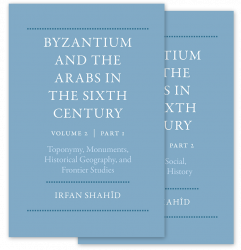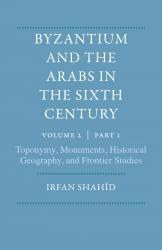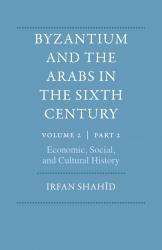Byzantium and the Arabs in the Sixth Century, Vol. 2

Shahîd describes the military, religious, social, and civil structures of the Ghassānids, as well as their contributions to the cultural environment in sixth-century Oriens, revealing the history of a unique Christian Arab culture.
Series information
 |
Byzantium and the Arabs in the Sixth Century, Vol. 2, Part 1 Byzantium and the Arabs in the Sixth Century, volume 2, part 1, Toponymy, Monuments, Historical Geography, and Frontier Studies is a topical study of the military, religious, and civil structures of the Ghassānids. Irfan Shahîd’s detailed study of Arab buildings of the sixth century illuminates how Byzantine provincial art and architecture were adopted and adapted by the federate Arabs for their own use. As monuments of Christian architecture, these federate structures constitute the missing link in the development of Arab architecture in the region between the earlier pagan (Nabataean and Palmyrene) and later Muslim (Umayyad). Drawing from literary and material evidence, Shahîd argues that the Ghassānids were not nomadic, as traditionally believed, but thoroughly sedentary both in their roots and in the late Roman frontier zone they inherited. The third of four volumes dedicated to the sixth century, this book extensively depends upon the previous two volumes (volume 1, part 1, Political and Military History; volume 1, part 2, Ecclesiastical History). |
 |
Byzantium and the Arabs in the Sixth Century, Vol. 2, Part 2 Byzantium and the Arabs in the Sixth Century, volume 2, part 2, Economic, Social, and Cultural History is a topical study of Arab economic, social, and cultural history in the sixth century. Irfan Shahîd focuses on the economy of the Ghassānids and presents information on various trade routes and fairs. He reconstructs Ghassānid daily life by discussing topics as varied as music, food, medicine, the role of women, and horse racing. Shahîd concludes with an examination of cultural life, including descriptions of urbanization, Arabic script, chivalry, and poetry. Throughout the volume, the author reveals the history of a fully developed and unique Christian Arab culture. Shahîd exhaustively describes the society of the Ghassānids and their contributions to the cultural environment that persisted in Oriens during the sixth century and continued into the Umayyad caliphate. |
Shahîd describes the military, religious, social, and civil structures of the Ghassānids, as well as their contributions to the cultural environment in sixth-century Oriens, revealing the history of a unique Christian Arab culture.
| Details | Books | |
|---|---|---|
|
Home town: Washington, D.C. |
Irfan Shahîd Associate Fellow at Dumbarton Oaks and Fellow of the Medieval Academy of America, Irfan Shahîd was Emeritus Professor of Arabic Studies at Georgetown University, where from 1982 to 2008 he was Oman Professor of Arabic and Islamic Literature. |
Byzantium and the Arabs in the Fifth Century, Byzantium and the Arabs in the Fourth Century, Byzantium and the Arabs in the Sixth Century, Vol. 1, Part 1, Byzantium and the Arabs in the Sixth Century, Vol. 1, Part 2, Byzantium and the Arabs in the Sixth Century, Vol. 2, Part 1, Byzantium and the Arabs in the Sixth Century, Vol. 2, Part 2, Rome and the Arabs |
